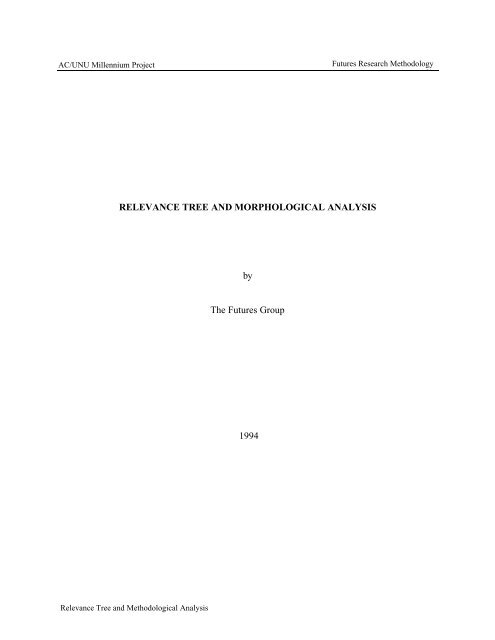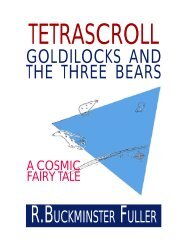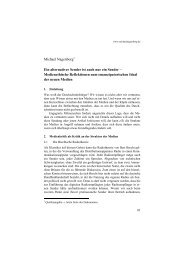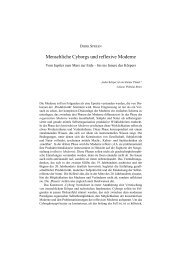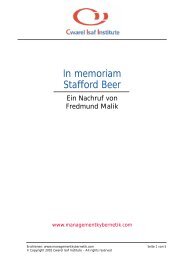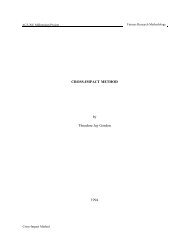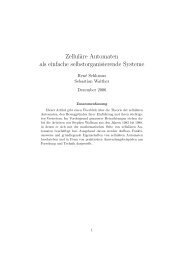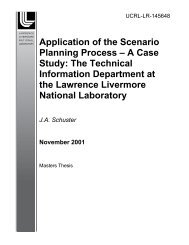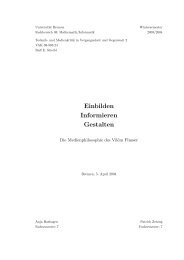RELEVANCE TREE AND MORPHOLOGICAL ANALYSIS by The ...
RELEVANCE TREE AND MORPHOLOGICAL ANALYSIS by The ...
RELEVANCE TREE AND MORPHOLOGICAL ANALYSIS by The ...
Create successful ePaper yourself
Turn your PDF publications into a flip-book with our unique Google optimized e-Paper software.
AC/UNU Millennium Project<br />
Futures Research Methodology<br />
<strong>RELEVANCE</strong> <strong>TREE</strong> <strong>AND</strong> <strong>MORPHOLOGICAL</strong> <strong>ANALYSIS</strong><br />
<strong>by</strong><br />
<strong>The</strong> Futures Group<br />
1994
AC/UNU Millennium Project<br />
Futures Research Methodology<br />
ACKNOWLEDGMENT<br />
<strong>The</strong> managing editor wish to thank the reviewers of this paper who made many important suggestions<br />
and contributions: Peter Bishop of the University of Houston, Larry Hills of United States Agency<br />
for International Development, and Peter Metter of Fachhochschule Wiesbaden. And finally, special<br />
thanks to Neda Zawahri for project support, Barry Bluestein for research and computer operations,<br />
and Sheila Harty for final editing of this document. Thanks to all for your contributions.<br />
Relevance Tree and Methodological Analysis
AC/UNU Millennium Project<br />
Futures Research Methodology<br />
CONTENTS<br />
ACKNOWLEDGMENTS<br />
I<br />
HISTORY<br />
II<br />
DESCRIPTION<br />
Relevance-Tree Analysis<br />
Morphological Analysis<br />
III<br />
IV<br />
V<br />
VI<br />
HOW TO DO IT<br />
STRENGTHS <strong>AND</strong> WEAKNESSES<br />
FRONTIERS<br />
SAMPLE OF APPLICATIONS<br />
BIBLIOGRAPHY<br />
Relevance Tree and Methodological Analysis
AC/UNU Millennium Project<br />
Futures Research Methodology<br />
I<br />
HISTORY<br />
A "relevance tree" is an analytic technique that subdivides a broad topic into increasingly smaller<br />
subtopics. <strong>The</strong> output is a pictorial representation with a hierarchical structure that shows how a<br />
given topic can be subdivided into increasingly finer levels of detail.<br />
"Morphological analysis" is a complementary technique, often used in conjunction with a relevance<br />
tree, that is used to identify new product opportunities. This technique involves mapping options to<br />
obtain an overall perspective of possible solutions.<br />
Morphological analysis was first applied to the aerospace industry <strong>by</strong> F. Zwicky, a professor at the<br />
California Institute of Technology. Zwicky chose to analyze the structure of jet engine technology.<br />
His first task was to define the important parameters of jet engine technology, which include thrust<br />
mechanism, oxidizer, and fuel type. He continued, in turn, to break each of these technologies down<br />
into its component parts. Having exhausted the possibilities under each parameter heading, the<br />
alternative approaches were assembled in all possible permutations: for example, a ramjet that used<br />
atmospheric oxygen and a solid fuel. For some permutations, a jet engine system already existed; for<br />
others, no systems or products were available. Zwicky viewed the permutations representing "empty<br />
cells" as stimuli for creativity and for each asked, "Why not?" For example, "Why not a nuclearpowered<br />
ceramic fan-jet?"<br />
Although Zwicky coined the term morphological analysis, the technique predates him and can be<br />
traced back to Ramón Lull (1235-1315), according to Lucien Gerardin. Zwicky was the first to use<br />
the technique in modern-day applications. <strong>The</strong> primary use of morphological analysis has been in<br />
technological forecasting and new product ideation. However, the technique can also be used in<br />
constructing scenarios.<br />
II<br />
DESCRIPTION<br />
Relevance-tree analysis has proven to be a powerful intellectual stimulus to ensure that a given<br />
problem or issue is prepared in comprehensive detail and that the important relationships among the<br />
items considered are shown in both current and potential situations.<br />
A relevance tree looks much like an organizational chart and presents information in a hierarchical<br />
structure. <strong>The</strong> hierarchy begins at a high level of abstraction and descends with greater degrees of<br />
detail in succeeding levels of the tree. <strong>The</strong> entries at a particular level, when taken together, are<br />
intended to describe completely the item to which they are connected in the level above. Ideally, each<br />
entry at a particular level is orthogonal; that is, it should not overlap with any other entry, thus being<br />
mutually exclusive of other entries. Finally, the items at a given level should be addressed from the<br />
Relevance Tree and Methodological Analysis 1
AC/UNU Millennium Project<br />
Futures Research Methodology<br />
"same point of view." <strong>The</strong>se conditions are often difficult to achieve in practice. If pursued properly,<br />
the structure can ultimately lead to a clearer understanding of the topic under analysis. For example,<br />
in the case shown here, the entries in the tree are descriptive of the socioeconomic characteristics of<br />
important interests involved in land use. Thus, the major branches in the tree might include the<br />
government, the public, business, and industry — as all are involved in some way with, and impacted<br />
<strong>by</strong>, federal land-use regulations. For the public, this branch might be described in terms of owners<br />
and leasers; owners, in turn, might be described in terms of living conditions, available services, and<br />
the environmental quality of their residence. At greater levels of detail, living conditions might be<br />
further defined <strong>by</strong> restrictions on ownership relating to residence size, type, location; conditions<br />
imposed on ownership of second homes; purchase costs; taxes, mortgage rates, etc. — all quantitative<br />
variables.<br />
Federal<br />
-number<br />
-budget<br />
State<br />
-number<br />
-budget<br />
Federal<br />
-number<br />
-budget<br />
-areas of authority<br />
State<br />
-number<br />
-budget<br />
-areas of authority<br />
Local<br />
-number<br />
-area of interestLocal<br />
-number<br />
-area of interest<br />
Federal<br />
State<br />
Living Conditions<br />
-ownership<br />
restrictions<br />
-costs<br />
-taxes<br />
-mortgages rates<br />
Availability<br />
services<br />
-type<br />
-costs<br />
-accessability<br />
Environmental<br />
quality<br />
-air pollution<br />
-water pollution<br />
-land quality<br />
Living conditions<br />
-rent<br />
-special fees<br />
Availability services<br />
-type<br />
-costs<br />
-accessability<br />
Environmental<br />
quality<br />
-air pollution<br />
-water pollution<br />
-land quality<br />
Available<br />
land<br />
-among<br />
-locations<br />
-restrictions<br />
Economics<br />
-land costs<br />
-interest rates<br />
-taxes<br />
Economic conditions<br />
-money demand<br />
-interest rates<br />
-taxes<br />
Money supply<br />
-amount<br />
-prime rate<br />
Economic<br />
conditions<br />
-market sales<br />
-money supply<br />
-money costs<br />
-profitability<br />
-taxes<br />
Operational<br />
restrictions<br />
-suiting<br />
-pollution<br />
regulations<br />
Economic<br />
conditions<br />
-market sales<br />
-money supply<br />
-money costs<br />
-profitability<br />
-taxes<br />
Operational<br />
restrictions<br />
-suiting<br />
-pollution<br />
regulations<br />
In the case of business and industry, their interests might be represented <strong>by</strong> land developers,<br />
financiers, manufacturers, and service industries. Manufacturers might be described in terms of their<br />
economic conditions related to sales of various products, money supply, the cost of money,<br />
profitability, and various tax regulations — also quantifiable variables. Operational restrictions for<br />
manufacturers might be further defined <strong>by</strong> various sitting criteria and pollution regulations. <strong>The</strong> same<br />
economic conditions might also describe the most important industrial sectors, such as agriculture,<br />
chemicals, energy, food processing, metals, minerals, transportation, and so on.<br />
Relevance Tree and Methodological Analysis 2
AC/UNU Millennium Project<br />
Futures Research Methodology<br />
<strong>The</strong> aim in relevance-tree analysis is to carry the level of detail to where the items or issues<br />
involved are sufficiently clear, preferably in quantified terms, so that their nature can be reviewed in<br />
terms of current conditions and potential options. In the land-use case, an assessment of demands<br />
and attitudes about consequences of alternative future federal land-use policies is more likely.<br />
Alternative assessments result because preparation of a relevance tree often leads to insights about<br />
future conditions and important interests that are not current factors in decision making.<br />
Morphological analysis is a proven ideation method that leads to "organized invention." <strong>The</strong><br />
technique allows for two key elements:<br />
• a systematic analysis of the current and future structure of an industry area (or domain) as<br />
well as key gaps in that structure.<br />
• a strong stimulus for the invention of new alternatives that fill these gaps and meet any<br />
imposed requirements.<br />
III<br />
HOW TO DO IT<br />
Morphological analysis involves mapping a discipline to obtain a wide perspective of existing<br />
solutions and future possibilities. Zwicky outlined five basic steps in the development of the<br />
morphological method:<br />
1. Formulation and definition of a problem;<br />
2. Identification and characterization of all parameters toward a solution;<br />
3. Construction of a multidimensional matrix (morphological box) whose combinations will<br />
contain all possible solutions;<br />
4. Evaluation of the outcome based on feasibility and achievement of desired goals; and<br />
5. In-depth analysis of best possibilities considering available resources.<br />
Steps 2 and 3 form the heart of morphological analysis since Steps 1, 4, and 5 are often involved in<br />
other forms of analysis. Step 2, identification of parameters, involves studying the problem and<br />
present solutions to develop a framework. This step can involve developing a relevance tree to help<br />
define a given topic. Once parameters are identified, a morphological box can be constructed that<br />
lists parameters along one dimension. <strong>The</strong> second dimension is determined <strong>by</strong> the nature of the<br />
problem.<br />
Relevance Tree and Methodological Analysis 3
AC/UNU Millennium Project<br />
Futures Research Methodology<br />
<strong>MORPHOLOGICAL</strong> BOX<br />
Values<br />
Parameters<br />
Parameter A<br />
Parameter B<br />
Parameter C<br />
Parameter D<br />
For example, the McDonnell Douglas corporation under contract to the National Aeronautics and<br />
Space Administration employed morphological analysis in an astronomy planning study. <strong>The</strong><br />
technique was used to explore three dimensions: astronomical bodies; portions of the<br />
electromagnetic spectrum; and particular parameters of interest, such as angular resolution. <strong>The</strong><br />
following matrix was developed with each cell representing a potential series of measurements.<br />
EXAMPLE OF A <strong>MORPHOLOGICAL</strong> BOX<br />
Source: <strong>The</strong>odore Gordon and M. J. Raffensperger, "<strong>The</strong> Relevance Tree Method for Planning<br />
Basic Research," A Guide to Practical Technological Forecasting, New Jersey: Prentice-<br />
Hall, 1973.<br />
Relevance Tree and Methodological Analysis 4
AC/UNU Millennium Project<br />
Futures Research Methodology<br />
<strong>The</strong> purpose of morphology is to organize information in a relevant and useful way in order to help<br />
solve a problem or stimulate new ways of thinking. No "right" or "wrong" way exists for<br />
constructing a morphology. Good knowledge about a problem or issue, however, is essential to<br />
developing the most effective morphological framework.<br />
A morphological framework could incorporate a relevance tree and define the parameters of<br />
the entertainment industry through either of two morphological diagrams:<br />
• Consumer Morphology. A "demand-side" morphology would identify the key parameters<br />
and subparameters of entertainment with regard to consumer issues, concerns, and needs.<br />
• Producer Morphology. A "supply-side" morphology would identify the key parameters and<br />
subparameters of entertainment with regard to how various options are made available to<br />
consumers.<br />
Current entertainment options would be arrayed in this framework, and trend analysis would<br />
describe the forces that shape the future of the industry and help identify new targets of opportunity.<br />
<strong>The</strong> Entertainment Consumer<br />
Relevance Tree and Methodological Analysis 5
AC/UNU Millennium Project<br />
Futures Research Methodology<br />
<strong>The</strong> Entertainment Producer<br />
Parameters at an appropriate level of detail would form a morphological matrix. Dimensions from<br />
the consumer morphology would follow the horizontal axis; dimensions from the producer<br />
morphology would follow the horizontal axis. A preliminary example of this type of matrix is shown<br />
below.<br />
Michel Godet posits that morphological analysis is also appropriate for scenario construction. <strong>The</strong><br />
Hudson Institute combined morphological analysis with scenarios to create a variety of nuclear threats<br />
and potential worlds. Godet describes scenarios as configurations of components, such as<br />
Relevance Tree and Methodological Analysis 6
AC/UNU Millennium Project<br />
Futures Research Methodology<br />
demographic, economics, etc., with a certain number of possible states for each of these components.<br />
In essence, a morphological space can define a range of possible scenarios.<br />
IV<br />
STRENGTHS <strong>AND</strong> WEAKNESSES<br />
A number of strengths give power to these techniques, including:<br />
Provision of new insights. Material is often presented in a manner that creates a greater<br />
understanding of a concept. Relevance trees can break down topics in new and insightful ways.<br />
Morphological analysis provides key insights on new research directions.<br />
• Richness of data. Morphological analysis can provide a multitude of combinations and<br />
permutations not yet explored.<br />
• Systematic analysis. <strong>The</strong>se techniques allow for a systematic analysis of the current and<br />
future structure of an industry (or system) and identification of key gaps.<br />
Potential drawbacks include:<br />
• An overabundance of possibilities. Morphological analysis may yield too many possibilities.<br />
Human judgments are still needed to direct the outcome.<br />
• Human error. <strong>The</strong> development of both relevance trees and morphological boxes requires<br />
critical judgments. If the underlying thought processes are not insightful, the outcomes of<br />
these methods will be weak.<br />
V<br />
FRONTIERS<br />
<strong>The</strong> large number of combinations derived <strong>by</strong> morphological analysis is often a hindrance to its use.<br />
In an effort to minimize this problem, Michel Godet introduced a methodological approach to<br />
scenarios, which involves a number of steps:<br />
• Identification of economic, technical, and strategic criteria to assess and select the best<br />
solutions;<br />
Relevance Tree and Methodological Analysis 7
AC/UNU Millennium Project<br />
Futures Research Methodology<br />
• Identification of crucial components and their classification <strong>by</strong> criteria of weighted differences;<br />
and<br />
• Introduction of constraints of exclusion or preference.<br />
This approach has been integrated into a micro-software package (MOPPHOL).<br />
<strong>The</strong> Futures Group (TFG) has developed a computer analysis program that facilitates the<br />
process and organizes the output in priority. In a recent study for a major chemical company, TFG<br />
used a general permutation program, customized for food care, to analyze food storage and food<br />
preparation technologies in priority. Two permutation programs were run: a food storage program,<br />
and a food preparation program. <strong>The</strong>se programs permuted all possible combinations of elements<br />
from the three subsystems to form a large set of potential products.<br />
For each subsystem element, two numbers were entered to describe how well each element<br />
met the two criteria:<br />
• Breakthrough potential; and<br />
• Relationship to client company.<br />
<strong>The</strong> criteria were weighted in terms of their importance to the client. For example, if a<br />
product has a high breakthrough potential, that criterion may be given a higher weight than<br />
relationship to client company. <strong>The</strong> computer program combined all possible permutations of all<br />
subsystem elements and derived a score for each product composed of those elements. <strong>The</strong> products<br />
were then rank-ordered according to their score so that the products coming closest to meeting all<br />
the criteria were listed first.<br />
Relevance Tree and Methodological Analysis 8
AC/UNU Millennium Project<br />
Futures Research Methodology<br />
<strong>The</strong> following journals cover new developments in morphological analysis:<br />
Futures<br />
Publisher: Butterworth-Heinemann<br />
Linacre House, Jordan Hill<br />
Oxford, OX2 8DP UK<br />
Phone +44 865 310166<br />
Fax: +44 865 310898<br />
Futures Research<br />
[Zukunftsforschung]<br />
Publisher: Swiss Society for Futures<br />
Research<br />
SZF, Haldenweg 10 A, Muri, Ch-3074,<br />
Switzerland<br />
Phone: 031-952-66-55<br />
Fax: 031-952-68-00<br />
Futures Research Quarterly<br />
Publisher: World Future Society<br />
7910 Woodmont Avenue, Suite 450<br />
Bethesda, MD 20814 USA<br />
Phone: (301) 656-8274 Fax: (301) 951-<br />
0394<br />
Futurescope<br />
Publisher: Decision Resources, Inc.<br />
17 New England Executive Park<br />
Burlington, MA 01803 USA<br />
Phone: (617) 270-1200 Fax: (617) 273-<br />
3048<br />
<strong>The</strong> Futurist<br />
Publisher: World Future Society<br />
7910 Woodmont Avenue, Suite 450<br />
Bethesda, MD 20814 USA<br />
Phone: (301) 656-8274<br />
Fax: (301) 951-0394<br />
Long-Range Planning<br />
Publisher: Pergamon Press<br />
Headington Hill Hall<br />
Oxford OX3 OBW UK<br />
Phone: (0865) 79141 Fax: (0865) 60285<br />
Social Indicators Network News (SINET)<br />
Publisher: P.O. Box 24064<br />
Emory University Station<br />
Atlanta, GA 30322 USA<br />
Phone: (404) 373-4756 Fax: (404) 727-<br />
7532<br />
Technological Forecasting and Social<br />
Change<br />
Publisher: Elsevier Science Publishing Co.,<br />
Inc.<br />
655 Avenue of the Americas<br />
New York, NY 10010 USA<br />
Phone: (212) 633-3941 Fax: (212) 633-<br />
3990<br />
Technology Forecasts and Technology<br />
Surveys<br />
Publisher: Technology Forecasts<br />
205 S. Beverly Drive, Suite 208<br />
Beverly Hills, CA 90212 USA<br />
Phone: (213) 273-3486<br />
Relevance Tree and Methodological Analysis 9
AC/UNU Millennium Project<br />
Futures Research Methodology<br />
VI<br />
SAMPLE OF APPLICATIONS<br />
Applications of relevance tree and morphological analysis abound.<br />
• Zwicky, developer of morphological analysis, claims over 30 industrial applications.<br />
• <strong>The</strong> Hudson Institute combined morphological analysis with scenarios to create a variety<br />
of nuclear threats and future possible worlds.<br />
• Look-Out Studies Group used the technique for Thomson-CSF in a study of<br />
communication <strong>by</strong> mass media.<br />
• TFG incorporated relevance trees and morphological analysis in numerous studies,<br />
including new product ideation for consumer products firms and role definition for the<br />
unmanned vehicles in current and future U.S. Coast Guard missions.<br />
Relevance Tree and Methodological Analysis 10
AC/UNU Millennium Project<br />
Futures Research Methodology<br />
BIBLIOGRAPHY<br />
Ayres, Robert U. "Morphological Analysis." Technological Forecasting and Long Range<br />
Planning. New York: McGraw-Hill, Inc., 1969, Chap. 5, pp. 72-93.<br />
Barbiroli, Giancarlo. "Towards a Definition and a Dynamic Measure of Strategic Technology."<br />
Technovation (TCH). ISSN: 0166-4972, Vol. 12, Iss: 5, July 1992, pp. 285-296.<br />
Bridgewater, A. V. "Long Range Process Design and Morphological Analysis." <strong>The</strong> Chemical<br />
Engineer, April 1968, pp. CE 75-CE 81.<br />
Bridgewater, A. V. "Morphological Methods — Principles and Practice." Technological<br />
Forecasting. R. V. Arnfield, ed. Conference on Technological Forecasting, University of<br />
Strathclyde, 1968. Edinburgh: University Press, 1969, pp. 241-252.<br />
Foray, Dominique, and Grubler, Arnulf. "Morphological Analysis, Diffusion and Lockout of<br />
Technologies: Ferrous Casting in France and the FRG." Research Policy, ISSN: 0048-7333,<br />
Vol. 19, Iss. 6, December 1990, pp. 535-550.<br />
Gerardin, Lucien. "Morphological Analysis: A Method for Creativity." A Guide to Practical<br />
Technological Forecasting. New Jersey: Prentice-Hall, 1973.<br />
Godet, Michel. From Anticipation to Action: A Handbook of Strategic Prospective, Paris,<br />
UNESCO, 1993.<br />
Gordon, <strong>The</strong>odore, and Raffensperger, M. J. "A Relevance Tree Method for Planning Basic<br />
Research." A Guide to Practical Technological Forecasting. New Jersey: Prentice-Hall,<br />
1973.<br />
Gregory, S. A. "Morphological Methods: Antecedents and Associates." Technological<br />
Forecasting, Some Techniques. Symposium at Aston University, Birmingham, September 9<br />
and 10, 1969.<br />
Hall, Arthur D. "Three-Dimensional Morphology of Systems Engineering." IEEE Transactions<br />
on Systems Science and Cybernetics, April 1969, pp. 156-160.<br />
Makridakis, Spyros, Wheelwright, Steven, and McGee, Victor. Forecasting: Methods and<br />
Applications. New York: John Wiley & Sons, 1983.<br />
Relevance Tree and Methodological Analysis 11
AC/UNU Millennium Project<br />
Futures Research Methodology<br />
Norris, K. W. "<strong>The</strong> Morphological Approach to Engineering Design." Conference on Design<br />
Methods. J. C. Jones and D. G. Thornley, eds. Elmsford, N.Y.: Pergamon Press, Inc., 1963,<br />
pp. 115-140.<br />
Royston, G. "Morphological Analysis and the Development of the Brewing Process."<br />
Technological Forecasting, Some Techniques. Symposium at Aston University, Birmingham,<br />
September 9 and 10, 1969.<br />
Watts, R. D. "Some <strong>The</strong>oretical Principles in Morphological Analysis." Technological<br />
Forecasting, Some Techniques. Symposium at Aston University, Birmingham, September 9<br />
and 10, 1969.<br />
Wills, R. J., and Hawthone, E. P. "Morphological Methods Applied to Metalworking Processes."<br />
Technological Forecasting, Some Techniques. Symposium at Aston University, Birmingham,<br />
September 9 and 10, 1969.<br />
Zwicky, Fritz. "Morphology and Nomenclature of Jet Engines." Aeron. Eng. Review, June 1947.<br />
Zwicky, Fritz. "<strong>The</strong> Morphological Method of Analysis and Construction." Courant.<br />
Anniversary Volume. New York: Intersciences Publish., 1948, pp. 461-470.<br />
Zwicky, Fritz. Discovery, Invention, Research, Through the Morphological Approach. <strong>The</strong><br />
Macmillan Co., 1968.<br />
Zwicky, Fritz. Morphological Astronomy. Berlin: Springer Verlag, 1957.<br />
Zwicky, Fritz. Morphology of Propulsive Power. Monographs on Morphological Research, No.<br />
1 Pasadena, California: Society for Morphological Research, 1962.<br />
Relevance Tree and Methodological Analysis 12


